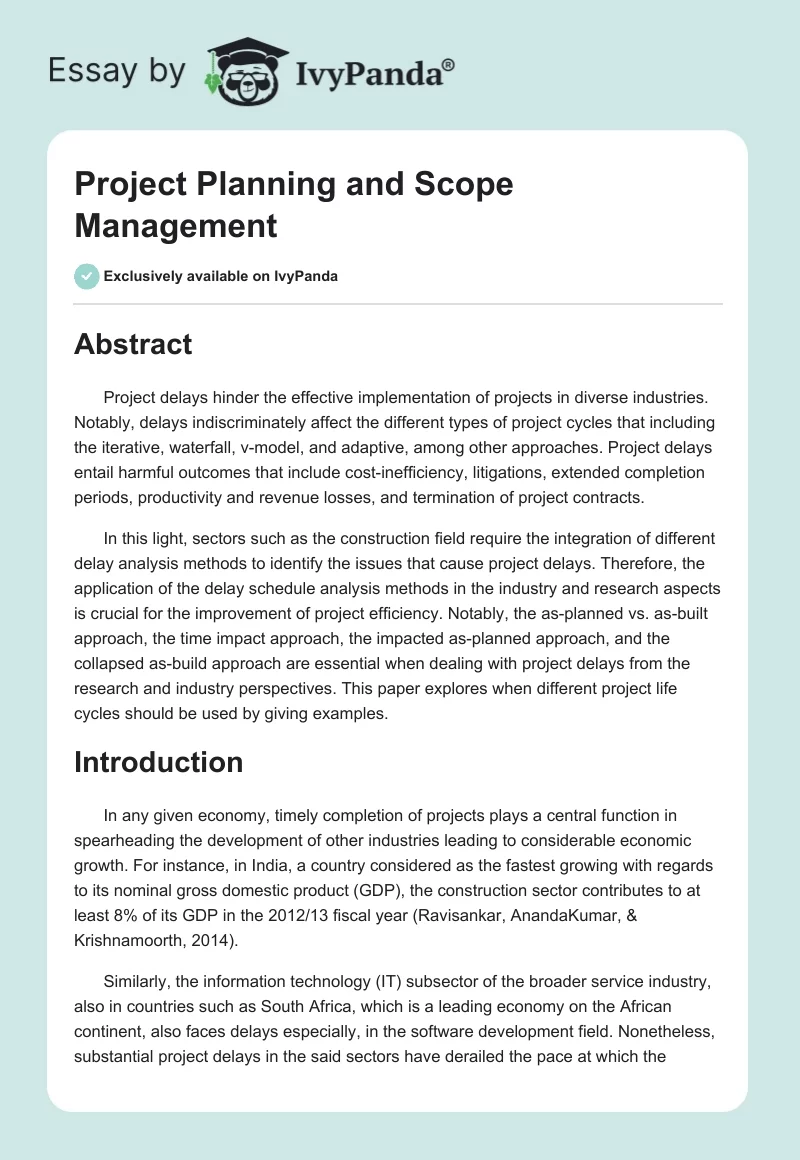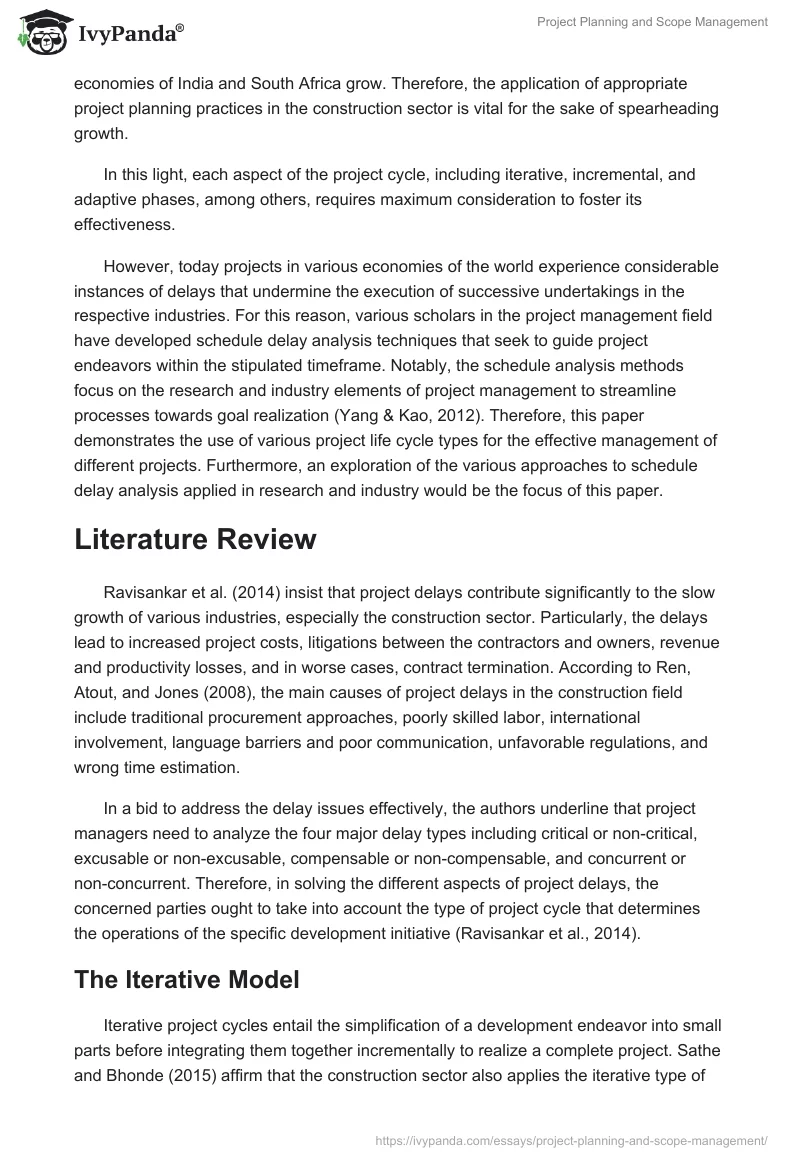Abstract
Project delays hinder the effective implementation of projects in diverse industries. Notably, delays indiscriminately affect the different types of project cycles that including the iterative, waterfall, v-model, and adaptive, among other approaches. Project delays entail harmful outcomes that include cost-inefficiency, litigations, extended completion periods, productivity and revenue losses, and termination of project contracts.
In this light, sectors such as the construction field require the integration of different delay analysis methods to identify the issues that cause project delays. Therefore, the application of the delay schedule analysis methods in the industry and research aspects is crucial for the improvement of project efficiency. Notably, the as-planned vs. as-built approach, the time impact approach, the impacted as-planned approach, and the collapsed as-build approach are essential when dealing with project delays from the research and industry perspectives. This paper explores when different project life cycles should be used by giving examples.
Introduction
In any given economy, timely completion of projects plays a central function in spearheading the development of other industries leading to considerable economic growth. For instance, in India, a country considered as the fastest growing with regards to its nominal gross domestic product (GDP), the construction sector contributes to at least 8% of its GDP in the 2012/13 fiscal year (Ravisankar, AnandaKumar, & Krishnamoorth, 2014).
Similarly, the information technology (IT) subsector of the broader service industry, also in countries such as South Africa, which is a leading economy on the African continent, also faces delays especially, in the software development field. Nonetheless, substantial project delays in the said sectors have derailed the pace at which the economies of India and South Africa grow. Therefore, the application of appropriate project planning practices in the construction sector is vital for the sake of spearheading growth.
In this light, each aspect of the project cycle, including iterative, incremental, and adaptive phases, among others, requires maximum consideration to foster its effectiveness.
However, today projects in various economies of the world experience considerable instances of delays that undermine the execution of successive undertakings in the respective industries. For this reason, various scholars in the project management field have developed schedule delay analysis techniques that seek to guide project endeavors within the stipulated timeframe. Notably, the schedule analysis methods focus on the research and industry elements of project management to streamline processes towards goal realization (Yang & Kao, 2012). Therefore, this paper demonstrates the use of various project life cycle types for the effective management of different projects. Furthermore, an exploration of the various approaches to schedule delay analysis applied in research and industry would be the focus of this paper.
Literature Review
Ravisankar et al. (2014) insist that project delays contribute significantly to the slow growth of various industries, especially the construction sector. Particularly, the delays lead to increased project costs, litigations between the contractors and owners, revenue and productivity losses, and in worse cases, contract termination. According to Ren, Atout, and Jones (2008), the main causes of project delays in the construction field include traditional procurement approaches, poorly skilled labor, international involvement, language barriers and poor communication, unfavorable regulations, and wrong time estimation.
In a bid to address the delay issues effectively, the authors underline that project managers need to analyze the four major delay types including critical or non-critical, excusable or non-excusable, compensable or non-compensable, and concurrent or non-concurrent. Therefore, in solving the different aspects of project delays, the concerned parties ought to take into account the type of project cycle that determines the operations of the specific development initiative (Ravisankar et al., 2014).
The Iterative Model
Iterative project cycles entail the simplification of a development endeavor into small parts before integrating them together incrementally to realize a complete project. Sathe and Bhonde (2015) affirm that the construction sector also applies the iterative type of project cycle to facilitate the completion of a fully erected structure. Essentially, the Iterative model integrates an incremental approach to project management since it involves various elements that create the whole.
For example, the individual building construction processes, including plumbing and drainage, landscaping, electrical installations, and the actual construction works, represent an iterative model project model. Such a model could trigger delays due to the challenges experienced in the independent processes, as seen in the case of concurrency, where delays occur independently and on different occasions. Furthermore, the rigidity aspect of the architecture that uses the iterative model causes costly delays since it does not avail of all the necessary resources for the project at once (Sathe & Bhonde, 2015).
The Incremental Model
In project management, the incremental model concentrates on the completion of a development endeavor through a series of additional steps that characterize its cyclic nature. The additional phases provide additional functionality to the product before completion (Yang & Kao, 2012). For example, in-vehicle assembly, this model is applied to realize a finished product by installing all the parts incrementally. However, due to the customer interaction aspect of such projects, delays could arise, thereby necessitating the incorporation of DAMs, such as the time impact analysis and the as-planned vs. as-built approaches.
The Adaptive Model
This model is also referred to as agile or change-driven approaches, and it fuses both the iterative and incremental models. The model emphasizes the customer interaction whereby, the feedback of the customer determines the pace of the project in a way that makes the project time-bound and rapid. Furthermore, due to the lack of clearly defines phases, the project delays issue affects this type of project cycle significantly (Shrestha, Shrestha, & Meyer, 2014). For example, complex construction projects could apply the adaptive model to satisfy the individual interest of the stakeholders involved. Besides the incorporation of DAMs, collaboration and coordination are encouraged in adaptive projects to curb delays.
The V model
The V model in project execution and management entails the adoption of sequential processes that form a V shape. The model emphasizes on the validation aspect of project management to counter issues such as delays. Mainly, the project design phase precedes the coding and validation phases to realize a complete project (Sathe & Bhonde, 2015). For example, the model is applicable in architecture design in the construction sector and operations management in the business setting, like in the case of a software developing company. However, the V model could lead to the issue of delay claims due to the different assessment results at different phases of the project. For this reason, Shrestha et al. (2014) argue that the delay claims arising from the V model could address the issue by concentrating on the prevention, preparation, and defense elements of such issues.
Research Objectives
The objectives of the inquiry entail the following
- To conduct an assessment of the various project cycles.
- To establish the essence of delay schedule analysis.
- To comprehend the influence of the project life cycle approach in a given project.
Schedule Delay Analysis in Industry
The application of the schedule delay analysis in the various industrial sectors is crucial for the completion of projects in time. In this light, the embracement of the key DAMs is important to combat the late completion of projects in different sectors, including construction (Ren et al., 2008). The two main DAMs applicable in the industry include the as-planned vs. as-built and the time impact analysis.
The as-planned vs. as-built approach
As a simple and inexpensive method, the applicability of the as-planned vs. as-built method entails a comparison of the baseline program with the as-built program to assess the triggers of project delay. The approach applies common sense in the assessment of concurrent delays that derail the attainment of the targeted completion deadline (Sathe & Bhonde, 2015).
The Time Impact Approach
The time impact method relies on the assumption that assessing the schedule updates in a series facilitates the evaluation of delay impacts on projects. Mainly, this approach enhances the management of disputes since it scrutinizes the different delay aspects in the entire project. Therefore, research undertakings focusing on delays could analyze the different causes of delay litigations. However, the time impact approach is costly and time consuming and thus, most organizations are discouraged from using it.
Schedule Delay Analysis in Research
In research undertakings, schedule delay analysis approaches are necessary to improve the execution of projects in future. Particularly, the impacted as-planned and collapsed as-build methods are highly applicable in the research setting, especially regarding construction projects. Besides, the Windows analysis method could also be used but its suitability is questionable in the current industrial atmosphere.
The Impacted as-planned Approach
When using the approach, managers solely consider the as-planned schedule in the delay analysis whereby the various delay causes are regarded as part of the as-planned critical path schedule in a way that shows how the delays affect the predetermined completion time. The schedule variations between the actual completion date and the additional time due to the delay demonstrate the project delay. Essentially, the model investigates the impact of the project in terms of time to evaluate its effectiveness (Ren et al., 2008).
The Collapsed as-built Approach
The method disregards the as-planned aspect of the project by focusing on the as-built critical path schedule that takes into account the entire delays in the project (Enshassi & Jubeh, n.d.). The research approach is accurate in assessing project delays since it identifies the difference between the delayed and scheduled time to develop a collapsed as-built schedule. Moreover, this method focuses on the issues that not only cause delays but also the failure or collapse of projects.
Conclusion
Notably, delays in the various project cycle types cause substantial detrimental results that affect the efficiency of the project. The various project cycles reveal that it is necessary to apply the suitable delay analysis method to curb the negative consequences of project delays that include cost increase, extended completion periods, and lawsuits among other issues. Furthermore, the different schedule analysis techniques applicable in the industry and research areas are crucial for combating the delays issue particularly, in the construction sector.
Essentially, the as planned vs. as-built and time impact approaches in the research element of delay schedule are important for the attainment of reliable projects in future. Similarly, the impacted as-planned and collapsed as-built approaches in the industry setting facilitate an evaluation of the path scheduling activities and their effect on the additional time in the project.
References
Enshassi, A., & Jubeh, A. (n.d.). Delay Analysis Methods and Factors Affecting their Selection in the Construction Industry in Gaza Strip. Web.
Ravisankar, L., AnandaKumar, S., & Krishnamoorth, V. (2014), Study on the Quantification of Delay Factors in Construction Industry. International Journal of Emerging Technology and Advanced Engineering, 4(1), 105-113.
Ren, Z., Atout, M., & Jones, J. (2008). Root causes of construction project delays in Dubai. Web.
Sathe, P., & Bhonde, B. K. (2015). Investigating delay analysis techniques for improving their proper uses in order to reduce frequent delay claims resolution difficulties for construction projects. International Journal of Advance Foundation and Research in Science & Engineering, 1, 325-331.
Shrestha, P., Shrestha, K., & Meyer, N. (2014). Delay claim analysis in the construction industry. Web.
Yang, B., & Kao, K. (2012). Critical path effect based delay analysis method for construction projects. International Journal of Project Management, 30(3), 385-397.


